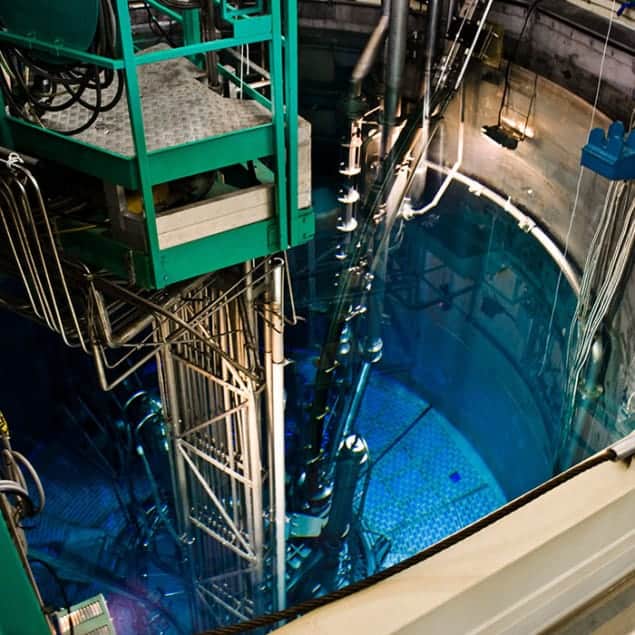
The first results from a detector designed to look for evidence of particles reaching us from a parallel universe have been unveiled by physicists in France and Belgium. Although they drew a blank, the researchers say that their experiment provides a simple, low-cost way of testing theories beyond the Standard Model of particle physics, and that the detector could be made significantly more sensitive in the future.
A number of quantum theories of gravity predict the existence of dimensions beyond the three of space and one of time that we are familiar with. Those theories envisage our universe as a 4D surface or “brane” in a higher-dimensional space–time “bulk”, just as a 2D sheet of paper exists as a surface within our normal three spatial dimensions. The bulk could contain multiple branes separated from one another by a certain distance within the higher dimensions.
Physicists have found no empirical evidence for the existence of other branes. However, in 2010, Michaël Sarrazin of the University of Namur in Belgium and Fabrice Petit of the Belgian Ceramic Research Centre put forward a model showing that particles normally trapped within one brane should occasionally be able to tunnel quantum mechanically into an adjacent brane. They said that neutrons should be more affected than charged particles because the tunnelling would be hindered by electromagnetic interactions.
Nearest neighbour
The researchers have now teamed up with physicists at the University of Grenoble in France and others at the University of Namur to put their model to the test. This involved setting up a helium-3 detector a few metres from the nuclear reactor at the Institut Laue-Langevin (ILL) in Grenoble and then recording how many neutrons it intercepted. The idea is that neutrons emitted by the reactor would exist in a quantum superposition of being in our brane and being in an adjacent brane (leaving aside the effect of more distant branes). The neutrons’ wavefunctions would then collapse into one or other of the two states when colliding with nuclei within the heavy-water moderator that surrounds the reactor core.
Most neutrons would end up in our brane, but a small fraction would enter the adjacent one. Those neutrons, so the reasoning goes, would – unlike the neutrons in our brane – escape the reactor, because they would interact extremely weakly with the water and concrete shielding around it. However, because a tiny part of those neutrons’ wavefunction would still exist within our brane even after the initial collapse, they could return to our world by colliding with helium nuclei in the detector. In other words, there would be a small but finite chance that some neutrons emitted by the reactor would disappear into another universe before reappearing in our own – so registering events in the detector.
If the brane energy scale corresponds to the Planck energy scale, there is no hope to observe this kind of new physics in a collider
Michaël Sarrazin, University of Namur
Sarrazin says that the biggest challenge in carrying out the experiment was minimizing the considerable background flux of neutrons caused by leakage from neighbouring instruments within the reactor hall. He and his colleagues did this by enclosing the detector in a multilayer shield – a 20 cm-thick polyethylene box on the outside to convert fast neutrons into thermal ones and then a boron box on the inside to capture thermal neutrons. This shielding reduced the background by about a factor of a million.
Stringent upper limit
Operating their detector over five days in July last year, Sarrazin and colleagues recorded a small but still significant number of events. The fact that these events could be residual background means they do not constitute evidence for hidden neutrons, say the researchers. But they do allow for a new upper limit on the probability that a neutron enters a parallel universe when colliding with a nucleus – one in two billion, which is about 15,000 times more stringent than a limit the researchers had previously arrived at by studying stored ultra-cold neutrons. This new limit, they say, implies that the distance between branes must be more than 87 times the Planck length (about 1.6 × 10–35 m).
To try and establish whether any of the residual events could indeed be due to hidden neutrons, Sarrazin and colleagues plan to carry out further, and longer, tests at ILL in about a year’s time. Sarrazin points out that because their model doesn’t predict the strength of inter-brane coupling, these tests cannot be used to completely rule out the existence of hidden branes. Conversely, he says, they could provide “clear evidence” in support of branes, which, he adds, could probably not be obtained using the LHC at CERN. “If the brane energy scale corresponds to the Planck energy scale, there is no hope to observe this kind of new physics in a collider,” he says.
Axel Lindner of DESY, who carries out similar “shining-particles-through-a-wall” experiments (but using photons rather than neutrons), supports the latest research. He believes it is “very important” to probe such “crazy” ideas experimentally, given presently limited indications about what might supersede the Standard Model. “It would be highly desirable to clarify whether the detected neutron signals can really be attributed to background or whether there is something else behind it,” he says.
The research is described in Physics Letters B.



